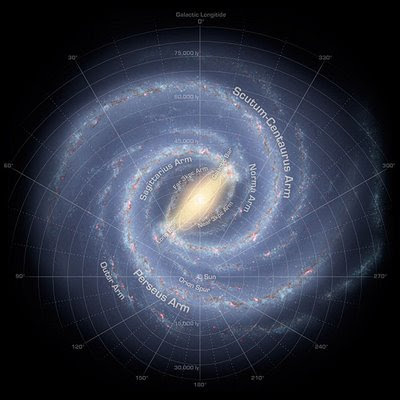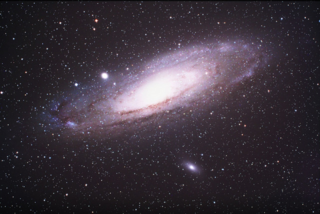
The Sun- WARNING! Be very careful when observing the Sun. You should either project the image onto a screen or use a filter designed specifically for solar observing. Be sure you cap off the finder scope so nobody accidentally takes a fatal peek or gets a hole burned through their clothes!
Normally, there are a few sun spots to show people, but the Sun has been pretty featureless lately. Sunspots only appear dark because they are cooler than the surrounding areas.
The Sun is so big you could fit 1.3 million Earths inside it.
The Sun does not rotate as a solid planet does. Instead, different portions rotate at different velocities. The equatorial region takes about 27 days to rotate, whereas the polar regions take 36 days.
The average distance to the Sun is 93 million miles.
It takes light approximately 8 minutes to get here from the Sun. If it were suddenly extinguished we wouldn't know for 8 minutes!

The Moon- The most obvious features on the Moon are craters, mountains and large flat areas called Maria. The best time to view the Moon is around first quarter. The Moon is up in the sky early for children and early risers, and the area bordering the shadow, the terminator, shows lots of contrast and interesting features, like the picture at right.
Craters are formed from asteroid and comet impacts. There are about a half million craters in the Moon bigger than 1 mile in diameter.
You can tell the relative age of features on the moon by the way they are placed in or on other features. A small crater inside a larger crater is younger than the large crater, for example.
The Moon takes 27.3 days to orbit the Earth.
Although it looks as though the moon keeps the same face to us all the time, we can actually see about 59% of the lunar surface due to an effect called libration.
 Jupiter- Jupiter is the fifth planet from the Sun and the largest.
Jupiter- Jupiter is the fifth planet from the Sun and the largest.It is two and a half times as massive as all the other planets combined.
Jupiter takes 11.8 years to circle the Sun.
Jupiter is perpetually covered with clouds composed mostly of ammonia. These clouds are arranged into bands at different latitudes. Wind speeds of up to 350mph and the conflicting circulation patterns of the clouds create gigantic storms.
The best known feature of Jupiter is the Great Red Spot, a storm that has been raging on Jupiter since at least 1831. The Great Red Spot is larger than Earth!
The four brightest moons of Jupiter are called the Galilean satellites, because the were discovered by Galileo in 1610. They are named Io, Europa, Ganymede and Callisto. Jupiter has 63 named natural satellites.

Milky Way- The Milky Way is the galaxy we live in. You can see the Milky Way in the sky with the naked eye if you are far enough away from the city and light pollution. What looks like a creamy band of light stretching across the sky is actually the combined light of millions of stars in our galaxy. The band of the Milky Way is the plane of our galaxy. We are looking at it from abut 2/3 of the way out in one of the galaxy's spiral arms. When you look towards the constellation Sagittarius, you are looking towards the center of our galaxy. As seem from above out galaxy probably looks about like this.
 The Milky Way galaxy is approximately 100,000 light years in diameter and contains between 200 and 400 billion stars.
The Milky Way galaxy is approximately 100,000 light years in diameter and contains between 200 and 400 billion stars.Only recently did we discover that our galaxy is actually a barred spiral galaxy, as shown above. All the gas and dust between us and the center and other side of the galaxy makes it difficult to study from within the galaxy at optical wavelengths. The Spitzer Space Telescope was able to study the central regions of our galaxy at infrared wavelengths in 2005 to give us a clearer picture of the true structure of our galaxy.
 M13- Messier 13 is also known as the Great Globular Cluster in Hercules Hercules or NGC 6205. It was discovered by Edmond Halley in 1714 and entered into the catalog of Messier objects by Charles Messier in June of 1764. At magnitude 5.8, it is just visible to the unaided eye from a dark sky site.
M13- Messier 13 is also known as the Great Globular Cluster in Hercules Hercules or NGC 6205. It was discovered by Edmond Halley in 1714 and entered into the catalog of Messier objects by Charles Messier in June of 1764. At magnitude 5.8, it is just visible to the unaided eye from a dark sky site.Its diameter is about 145 light-years, and it is composed of several hundred thousand stars. M13 is 25,100 light-years away from Earth.

M57- The Ring Nebula is easily one of the most famous deep sky objects. Located east of the Hercules Cluster, M13, its usually the next stop on a typical star party tour. It is approximately 2300 light years away in the constellation of Lyra.
The 'Ring' is comprised of gas shed from the outer atmosphere of a highly evolved star in its last stages of life before becoming a white dwarf. In fact, with a large enough telescope, at the center of M57 you can see the this stellar remnant shining dimly at 15th magnitude.
 M27- M27, the Dumbbell Nebula is another example of a planetary nebula like M57. This one is about 1200 light years away in the constellation Vulpecula.
M27- M27, the Dumbbell Nebula is another example of a planetary nebula like M57. This one is about 1200 light years away in the constellation Vulpecula.Planetary nebulae are formed when medium or low mass stars, like our the Sun, exhaust the hydrogen fuel in their stellar core. Changes in the star's interior causes the outer layers of the star to expand and it becomes a red giant. The outer atmospheres of these red giants are expelled by hot stellar winds. This expanding gaseous shell forms a nebula, illuminated by ultraviolet light from the central star.
 M20- Located in Sagittarius, this object is also known as the Trifid Nebula and NGC 6514. This one is a deep sky delight. The name means 'divided into three lobes'. M20 is actually a reflection nebula, emission nebula, dark nebula and star cluster all in one.
M20- Located in Sagittarius, this object is also known as the Trifid Nebula and NGC 6514. This one is a deep sky delight. The name means 'divided into three lobes'. M20 is actually a reflection nebula, emission nebula, dark nebula and star cluster all in one.NOTE: Explain to your guests that you don't see all the glorious colors shown in these photographs when looking through the eyepiece of a telescope. In fact, some images are made clearer by adding false color to them, colors that are not even there visually.

M31- The Andromeda Galaxy. As the evening wears on Andromeda rises higher and higher in the east. I usually show people how to star hop with the unaided eye from the square of Pegasus, up to Beta Andromeda and then up to M31. Then once they have glimpsed it with the unaided eye, I tell them the light that they saw just now left Andromeda 2.5 million years ago, and just got here today to be seen by them. After such a long trip, it's a good thing it wasn't wasted!
By this time, many of your observing guests will actually be getting used to looking through the eyepiece and they will glean more detail than they were when they first began.
Viewed in small telescopes, M31 is usually disappointing to the uninitiated. They expect to see glorious spiral structure and color. It really just looks like an elongated cloud. In very large telescopes the oohs and aahs can be heard across the observing field. Its a good one to end the night with.

1 comment:
hey! i need this kinda information for my science project!
ahhhhhhh!!!!
keep up and update more information!
thanks for your help!
Post a Comment